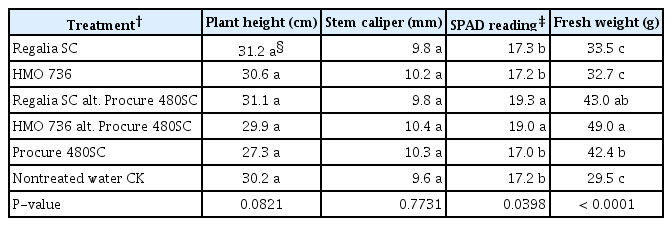Management of Powdery Mildew in Squash by Plant and Alga Extract Biopesticides
Article information
Abstract
Although many fungicides are registered for use to control powdery mildew on cucurbits, management of resistance to fungicides in pathogen populations still remains a major challenge. Two biopesticides Regalia SC and HMO 736 were evaluated in the greenhouse and field for their efficacy against powdery mildew in squash. In greenhouses, Regalia SC alone significantly (P < 0.05) reduced powdery mildew compared to the nontreated control, and was as effective as the chemical standard Procure 480SC (triflumizole). In alternation with Procure 480SC, Regalia SC demonstrated greater or equivalent effects on reducing the disease. HMO 736 alone showed varying levels of disease control, but alternating with Procure 480SC significantly improved control efficacy. In addition, application of Regalia SC or HMO 736 each in alternation with Procure 480SC significantly increased the chlorophyll content in leaves and the total fresh weight of squash plants, when compared with the water control, Regalia SC and HMO 736 alone. In field trials, application of Regalia SC and HMO 736 each alone significantly reduced disease severity in one of two field trials during the early stage of disease development, but not during later stages when disease pressure became high. Both Regalia SC and HMO 736 each applied in alternation with Procure 480SC significantly improved the control efficacy compared to Procure 480SC alone. Results from this study demonstrated that an integrated management program can be developed for powdery mildew in squash by integrating the biopesticides Regalia SC, HMO 736 with the chemical fungicide Procure 480SC.
Introduction
Powdery mildew, caused by Podosphaera xanthii (syn. Sphaerotheca fuliginea auct. p.p. [Schlechtend: Fr.] Pollacci), is a serious disease of cucurbits in most areas of the world (McGrath and Thomas, 1996; Nuñez-Palenius et al., 2009). Powdery mildew occurs frequently in the greenhouse and field production of cucurbits resulting in reduced plant growth, premature defoliation, and consequently adverse impact on yields. Yield loss is proportionally related to disease severity and the time when plants are infected (Mossler and Nesheim, 2001). It is reported that a negative linear relationship existed between cucumber yields and disease severity of powdery mildew (Dik and Albajes, 1999). In Florida, powdery mildew is one of the major foliar diseases of squash, and occurs in approximately 70% of the squash acreage in the state (Nuñez-Palenius et al., 2009; Seal et al., 2006). If it is not controlled effectively, this disease can be severe enough to cause extensive yield loss due to premature defoliation of leaves.
To manage powdery mildew disease in cucurbits, an integrated approach using a combination of several practices including cultural, chemical, and biological control practices should be considered (Nuñez-Palenius et al., 2009). However, crop rotation have a negligible or no effect on powdery mildew development because conidia of the pathogen are prevalent in the field (Gay et al., 1985). Tolerance to powdery mildew is limited in squash and some other cucurbit crops (Olson et al., 2010). The management of powdery mildew of cucurbits, therefore, primarily depends on repeated foliar applications of fungicides (Matheron and Porchas, 2013; McGrath, 1996b; McGrath and Thomas, 1996). However, chemical applications may have deleterious effects on the environment, and often result in the development of resistance in the pathogen that is resistant or tolerant to the fungicide applied (McGrath, 1996a, 2001). It has been reported that strains of P. xanthii developed resistance to the fungicides benomyl and triadimefon throughout the United States (McGrath, 1996a; McGrath et al., 1996). To achieve effective control of powdery mildew, the use of fungicides must be carefully selected and their applications must be wisely managed.
Many reports on control efficacy of plant extract biopesticides against powdery mildew have been published on several crops. Among these are Regalia SC, an aqueous product containing an ethanolic extract from Reynoutria sachalinensis (Marrone Bio Innovations Inc., Davis, CA, USA), and Milsana, a commercial biopesticide with the same active ingredient (KHH BioScience Inc., Raleigh, NC, USA). Promising results with these liquid formulations were previously reported on cucumber for control of powdery mildew (Daayf et al., 1995; Dik and van der Staay, 1995; Konstantinidou-Doltsinis and Schmitt, 1998; Petsikos-Panayotarou et al., 2002; Wurms et al., 1999). Regalia SC is registered in the USA and other regions for use on many crops to control a number of foliar diseases both in the greenhouse and field. Except for cucumber, the extract of R. sachalinensis has been demonstrated efficacy against powdery mildew on tomato (Konstantinidou-Doltsinis et al., 2006), apple, begonia, and wheat (Herger et al., 1988) when applied proactively. It was reported that Milsana reduced powdery mildew by 90% in greenhouse-grown cucumbers under high disease pressure (Konstantinidou-Doltsinis and Schmitt, 1998). Similar success was achieved using Milsana against powdery mildew on greenhouse tomatoes with a 42.2% to 64.6% reduction in disease severity, equivalent to wettable sulphur, but less effective than fungicides (Konstantinidou-Doltsinis et al., 2006). Laboratory tests showed that Milsana had a direct effect on conidial germination of Leveillula taurica (Lév.) Arn., the pathogen of powdery mildew of tomato. In addition, Daayf et al. (1995, 1997) reported that Milsana induced resistance in cucumber leaves against powdery mildew, particularly when the cucumber plants were infected with the pathogen S. fuliginea.
HMO 736 is a biopesticide of Laboratoires Goëmar (Saint-Malo, France) containing laminarin, a water soluble β-1, 3 glucan, extracted from the brown alga Laminaria digitata (Read et al., 1996). Laminarin was reported to trigger defense responses in cell suspensions of rice (Inui et al., 1997), alfalfa (Cardinale et al., 2000), tobacco (Klarzynski et al., 2000), and grapevine (Aziz et al., 2003). Ménard et al. (2004) reported that, after chemical sulfation, laminarin became an inducer of the salicylic acid signaling pathway in tobacco and Arabidopsis thaliana. Defense responses triggered by β-1, 3 glucan sulfate include activation of mitogen-activated protein kinases, Ca2+ influx, oxidative burst, and alkalinization of the extracellular medium. In tobacco and grapevine plants, laminarin induced the accumulation of phytoalexins and production of pathogenesis-related proteins (Aziz et al., 2003; Klarzynski et al., 2000).
Although many reports are available on efficacy of plant extract biopesticides against powdery mildew, none were published on squash. The objectives of this study were to evaluate the effects of the plant extract biopesticide Regalia SC and the alga extract biopesticide HMO 736 on powdery mildew of squash, and to determine whether alternating application of the extract biopesticides each with a conventional fungicide triflumizole (Procure 480SC) could improve control of powdery mildew in squash. Squash is primarily produced in the open field; however, greenhouse production is also important in some regions. Therefore, this study was conducted both in the greenhouse and under field conditions.
Materials and Methods
Extract biopesticides and conventional fungicide
The plant and alga extract biopesticides evaluated in this study were Regalia SC and HMO 736, respectively. Regalia SC provided by Marrone Organic Innovations (Davis, CA, USA) was a 5% formulation of extract from giant knotweed (R. sachalinensis). HMO 736 contained 3.51% laminarin from Laboratoires Goëmar. Regalia SC and HMO 736 were evaluated individually or in alternation with triflumizole (Procure 480SC; Chemtura Corporation, Middlebury, CT, USA), a conventional fungicide for control of powdery mildew that is registered for use on cucurbits, for their efficacy to control powdery mildew of squash in the greenhouse and field trials in South Florida.
Greenhouse trials
Plant material and treatment
Seeds of squash were planted in 10-cm-diameter plastic pots containing soilless Pro-mix medium (Miracle-Gro Lawn Products Inc., Marysville, OH, USA), and watered daily in a greenhouse. Osmocote® PLUS (15-9-12; SCOTTS-SIERRA Horticultural Products Company, Marysville, OH, USA), a controlled release fertilizer, was mixed with Pro-mix growing medium at a rate of 1.3% (w/w) prior to planting. Greenhouse experiments were conducted with five foliar pesticide treatments that included Regalia SC and HMO 736 each applied alone, in alternation with Procure 480SC, Procure 480SC alone, plus a water-treated control (a non-treated control). All foliar treatments started 1 week after planting (WAP) seed, i.e., the cotyledon stage. Regalia SC and HMO 736 were each applied alone weekly, or alternated with Procure 480SC every 2 weeks. Procure 480SC, the fungicide standard, was applied every 2 weeks. The application rate was 1% (v/v) for Regalia SC and 2.74 ml/l for HMO 736 which were equivalent to 1.02 l/ha for application in the field. In the first greenhouse experiment, summer squash cv. ‘Goldbar’ was planted and Procure 480SC was applied at the highest label rate of 1.56 ml/l which was equivalent to the field application rate of 584 ml/ha. In the second experiment, a squash cv. ‘Medallion’ was used and Procure 480SC was applied at a half rate of the highest label rate (0.78 ml/l). Squash plants were treated by spraying the treatment solutions onto foliage until runoff by using a 1-lilter handheld sprayer. A total of five applications were made in each repeated experiment from 1 to 5 WAP.
Inoculation with P. xanthii and disease rating
Greenhouse experiments were conducted in a controlled greenhouse at the University of Florida’s Tropical Research and Education Center (TREC) in Homestead, FL, USA. When the leaves had dried after the first treatment with the biopesticides or Procure 480SC at 1 WAP, squash plants were moved onto benches in another greenhouse and placed along with 15 squash plants with powdery mildew symptoms as a source of infection. On the source plants, about 50% of the canopy were covered with powdery mildew colonies on fully developed leaves. The source plants with powdery mildew were maintained in the greenhouse for 3–4 WAP before the experimental squash plants were moved into the same greenhouse. Disease severity of powdery mildew was rated weekly beginning at 3 WAP for 4 weeks in experiment 1 and for 3 weeks in experiment 2. At the last assessment plants had about seven and eight expanded leaves in experiments 1 and 2, respectively. Each plant was visually rated for disease severity based on estimation of the percentage of the leaf surfaces covered with powdery mildew lesions on fully expanded leaves. The youngest leaves (usually two or three), which were typically symptomless, were excluded in the disease rating. Area under the disease progress curve (AUDPC) values were calculated based on the formula Σ[{(xi + xi−1)/2}(ti − ti−1)], where xi is the rating at each evaluation time and (ti − ti−1) is the time between evaluations, analyzed by ANOVA, and means separated by Fisher’s protected least significant difference (LSD) at P = 0.05. Both greenhouse experiments were arranged in a randomized complete block (RCB) design with eight replications for each treatment and one plant for each replication. Three repeated trials as described above were conducted in greenhouse experiment 1, and two were carried out in experiment 2.
Effect of extract biopesticides on growth of squash
Height of squash plants was measured from the soil surface to the base of the blade of the top leaf at 4 WAP from trials 1 and 2 in the greenhouse experiment 1 as described previously. The caliper (diameter) of the plant stem was determined for each plant above the first node where the cotyledons emerged from the stem by using a certified digital caliper (Fisher Scientific, Northlake, IL, USA). Chlorophyll content in leaves was determined using a Minolta Chlorophyll Meter (model SPAD-502; Spectrum Technologies Inc., Plainfield, IL, USA). Three measurements of chlorophyll content were made on the second fully developed leaf from the top of each plant, and the average value was used for data analysis. Total fresh weight of squash plants was determined at 6 WAP following disease rating by rinsing the loose soil off the roots, blotting away excess water, and weighing the entire plant on an electronic scale.
Field trials
Two field trials were conducted at TREC in Homestead, FL, USA during 2009–2010 to evaluate the efficacy of the biopesticides Regalia SC and HMO 736 for control of powdery mildew in squash. The application rate was 1% (v/v) for Regalia SC and 1.02 l/ha for HMO 736 which was equivalent to 2.74 ml/l for application in the greenhouse based on the application volume of 383 l/ha. All field practices including land preparation, fertility, irrigation, weed control, and pest management followed the guidelines of the University of Florida’s Institute of Food and Agricultural Sciences (IFAS) (Olson et al., 2010).
Seeds of squash were sown into the soil of raised beds previously fumigated with methyl bromide:chloropicrin (67:33) at 393 kg/ha and covered with metalized polyethylene mulch (Canslit Inc., Victoriaville, QC, Canada). The beds were 15 cm high by 76 cm wide, and with 2.74 m between bed centers. In field trial 1, summer squash HMX 5703 F1 hybrid (Harris Moran Seed Co., Modesto, CA, USA) was direct seeded into fumigated beds covered with metalized plastic mulch on November 23, 2009. In field trial 2, seeds of squash cv. ‘Medallion’ (Abbott & Cobb Inc., Feasterville, PA, USA) were planted on March 1, 2010. At each site, three squash seeds were initially sown and seedlings were thinned 2 WAP to 51 cm plant-to-plant spacing on the bed. The same six treatments as previously described for the greenhouse experiments were included in both field trials, and the treatments were arranged in a RCB design. Twelve plants were planted in each plot which was 6 m long on a single bed with 1.5 m buffer zones maintained between adjacent plots.
In both field trials, squash plants were infected with naturally occurring P. xanthii. In field trial 1, foliar treatments were applied with a CO2-assisted back pack sprayer calibrated to deliver 374 l/ha starting at 17 days after planting (DAP) seed, when no symptoms of powdery mildew were found on squash plants in the untreated control plots. Additional applications were made at 24, 31, 38, 45, 52, 59, 66, and 73 DAP. Procure 480SC was applied at the highest label rate of 584.6 ml/ha. Treatments were applied weekly for extract biopesticides alone, once every week for the biopesticides or Procure 480SC in alternating treatments and also for Procure 480SC. Plots were regularly monitored for occurrence of powdery mildew, and the disease was rated at 60, 74, 80, and 88 DAP. Disease severity of powdery mildew on both sides of leaves was evaluated on five randomly selected plants in each plot by visual assessments of the entire canopy using a rating scale of 0–5, where 0 = no symptoms; 1 = no dead leaves, powdery mildew present as scattered lesions; 2 = less than 1/3 of leaves dead and scattered lesions on remainder; 3 = less than 1/3 of leaves dead and concentrated lesion development on remainder leaves; 4 = 1/3 to 2/3 of leaves dead; and 5 = more than 2/3 of leaves dead (O’Brien et al., 1988).
In field trial 2, the application rate of Procure 480SC was reduced to a half of the label rate, i.e., 292.3 ml/ha. In addition, a treatment with Procure 480SC alone at the label rate of 584.6 ml/ha was included as the standard fungicide control. Foliar treatments were applied with a CO2-assisted back pack sprayer calibrated to deliver 374 l/ha starting 24 DAP, when approximately a half of old leaves were infected in the untreated control plots with three to four colonies found on each of these leaves. Continued treatments were made 31, 38, 44, 51, and 59 DAP. Disease severity of powdery mildew on both leaf sides was visually rated on the entire canopy at 59, 71, and 77 DAP, and was recorded as the percentage of the leaf surface covered with powdery mildew colonies on fully developed leaves (Horsfall and Barratt, 1945). AUDPC was calculated throughout the period of experiment in both field trials. Marketable fruits were harvested three times in trial 1 and two times in trial 2, and combined yields from all harvests in each trial were recorded for data analysis.
Statistical analysis
Values of disease severity were converted to mid-percentages prior to statistical analysis. Data of disease and fruit yields in the greenhouse and field experiments were subjected to analysis of variance (ANOVA). The significance of treatment effects was determined by the magnitude of the F value (P ≤ 0.05). Separation of means was accomplished by Duncan’s multiple range and LSD using the Statistical Analysis System (SAS) package version 9.2 (SAS Institute Inc., Cary, NC, USA). Data of powdery mildew disease from the greenhouse experiments were not pooled after statistical analysis demonstrated that experiment by treatment interactions were significant (P ≤ 0.05).
Results
Greenhouse trials
In greenhouse experiment 1, treatment with Regalia SC alone significantly (P < 0.05) reduced AUDPC of powdery mildew on squash cv. ‘Goldbar’ compared to the non-treated control, and the treatment was as effective as Procure 480SC, the standard fungicide applied at the label rate of 584 ml/ha (Table 1). Regalia SC, when applied in alternation with Procure 480SC, provided significant protection against powdery mildew in all three repeated trials. Although HMO 736 alone showed inconsistent effects on suppression of powdery mildew among three greenhouse trials, alternating applications with Procure 480SC consistently decreased AUDPC when compared to the non-treated control. Regalia SC in alternation with Procure 480SC had greater effects in trial 1 on reduction of powdery mildew compared to Regalia SC or Procure 480SC alone.
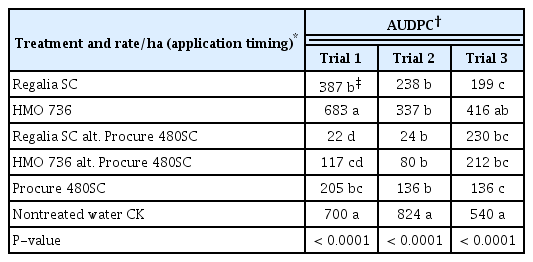
Severity of powdery mildew on summer squash cv. ‘Goldbar’ following treatment with biopesticides and fungicide triflumizole (Procure 480SC) in a greenhouse (experiment 1)
In greenhouse experiment 2 in which squash cv. ‘Medallion’ was used and Procure 480SC was applied at a half rate of label (292 ml/ha), Regalia SC alone significantly (P < 0.05) reduced AUDPC of powdery mildew compared to the non-treated control in both repeated trials (Table 2). HMO 736 varied in its efficacy for controlling powdery mildew when it was applied alone. Application of Regalia SC and HMO 736 each in alternation with Procure 480SC at a half rate of label consistently lowered AUDPC when compared with the non-treated control. Suppression of powdery mildew by Regalia SC in alternation with Procure 480SC at a half label rate was equivalent to Procure 480SC, the standard fungicide control, whereas that by HMO 736 in alternating treatment with Procure 480SC was inferior to Procure 480SC.
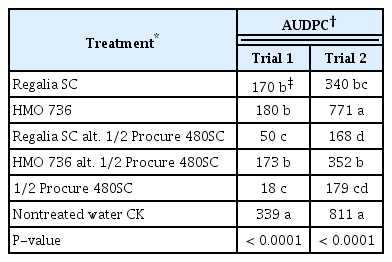
Effects of extract biopesticides applied alone or in alternation with triflumizole (Procure 480SC) at a half label rate on powdery mildew of summer squash (cv. ‘Medallion’) under greenhouse conditions (greenhouse experiment 2)
Alternating application of Regalia SC and HMO 736 each with Procure 480SC at the label rate (584 ml/ha) significantly increased the chlorophyll content in leaves and the total fresh weight of squash plants compared to the non-treated control, the extract biopesticides alone, and the standard chemical Procure 480SC (Table 3). None of the extract biopesticides applied alone had significant effects on any parameters of plant growth in this study.
Field trials
In field trial 1, Regalia SC significantly (P < 0.05) reduced AUDPC across four disease ratings compared to the non-treated control (Zhang, 2010). Treatments with the extract biopesticides each applied in alternation with Procure 480SC at 584 ml/ha resulted in significantly lower AUDPC than the non-treated control. In the first rating on 60 DAP after the 7th application, squash plants treated with both biopesticides individually significantly reduced disease severity compared to the non-treated control (Fig. 1). Greater disease suppression was obtained with the alternating treatments, and best control was obtained with Procure 480SC applied alone. In the rating on 74 DAP, only Regalia SC significantly reduced the disease severity compared to the non-treated control. In two late ratings on 80 and 88 DAP, none of the biopesticides alone significantly reduced powdery disease, but this was 7 and 15 days after the last application, respectively. In all disease ratings, alternating application of each biopesticide with Procure 480SC resulted in significantly lower disease ratings compared to each product alone. In addition, alternating application of HMO 736 with Procure 480SC significantly increased the yield of squash, so much that the resulting yield was increased by 84% of the non-treated control, but not different from Procure 480SC alone (Zhang, 2010). Treatment with Regalia SC alone increased the yield by 34% and its alternation with Procure 480SC increased yields by 44% compared to the non-treated control, albeit not significantly.
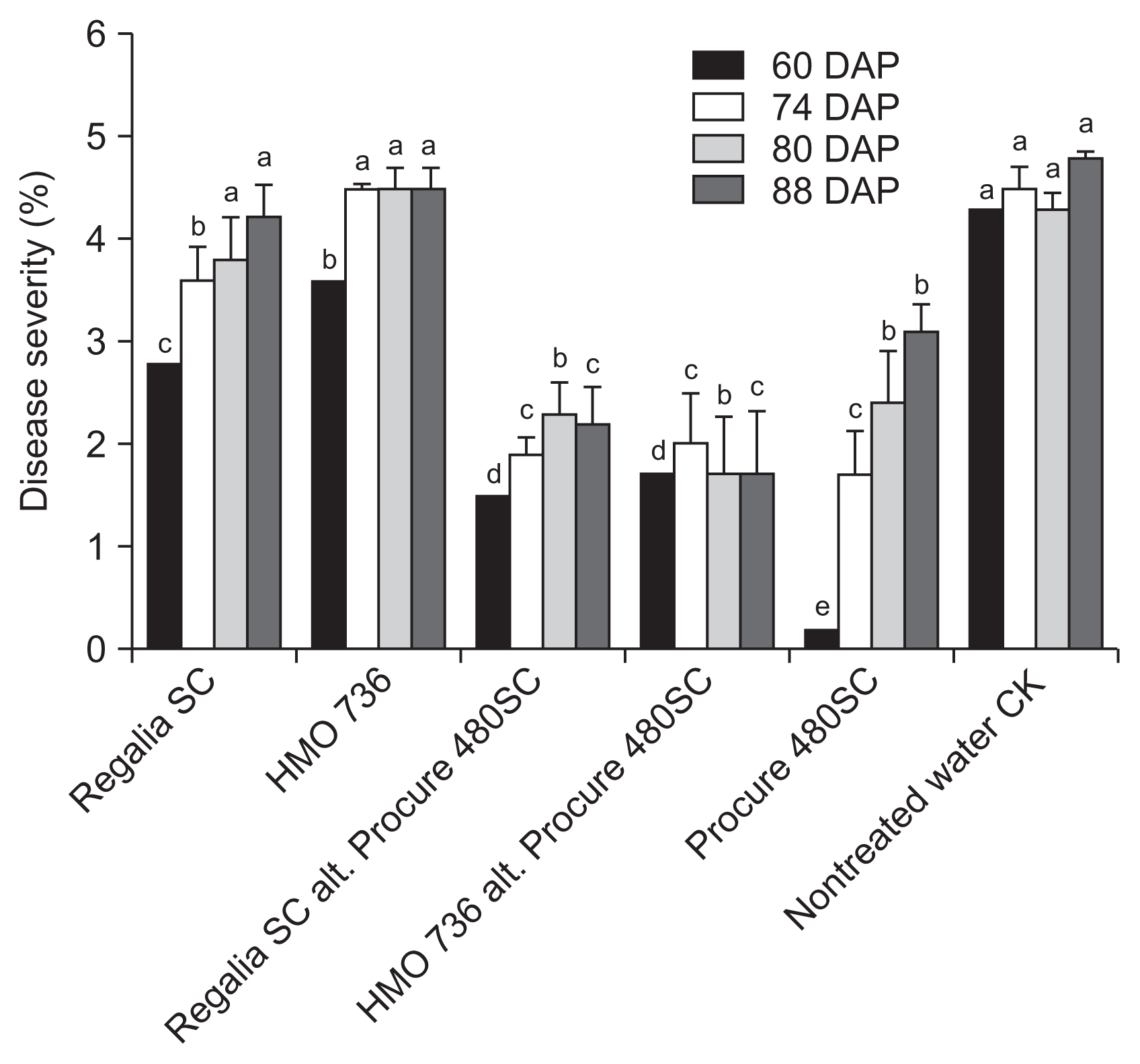
Efficacy of the extract biopesticides Regalia SC and HMO 736 on powdery mildew of summer squash HMX 5703 F1 hybrid (field trial 1). The application rate was 1% (v/v) for Regalia SC and 1.02 l/ha for HMO 736 which was equivalent to 2.74 ml/l for application in the greenhouse based on the application volume of 383 l/ha. Treatments were applied once a week for biopesticides alone, and once every 2 weeks for each of the biopesticides and Procure 480SC in alternating (alt.) treatments, and for Procure 480SC alone. Disease severity was evaluated on five randomly selected plants per plot 60, 74, 80, and 88 days after planting (DAP) by visually assessing entire canopy by a rating scale of 0 to 5, where 0 = no symptoms, and 5 = the highest level of powdery mildew. Means on each rating date followed by the same letter are not significantly different (P = 0.05) according to the least significant difference test. Bars represent the standard error of the mean.
In field trial 2, the extract biopesticides Regalia SC and HMO 736 each applied in alternation with Procure 480SC at a half rate of label, i.e., 292 ml/ha significantly reduced AUDPC of powdery mildew (Table 4). Based on a rating conducted 59 DAP, alternating applications of both biopesticides each with Procure 480SC at 292 ml/ha significantly reduced powdery mildew when compared with the non-treated control (Fig. 2). At the ratings on 71 DAP and 77 DAP, Procure 480SC demonstrated greater effects on disease reduction when applied at a full label rate than at a half rate. Regalia SC in alternation with Procure 480SC at 292 ml/ha significantly reduced disease severity of powdery mildew compared to the non-treated control, and the effect at rating on 77 DAP was as effective as Procure 480SC at 584 ml/ha. The combined effect was significantly greater than that of Procure 480SC at 292 ml/ha alone.

Effect of extract biopesticides applied separately or alternatively with triflumizole (Procure 480SC) at a half rate of label on powdery mildew and yield of squash cv. ‘Medallion’ (field trial 2)
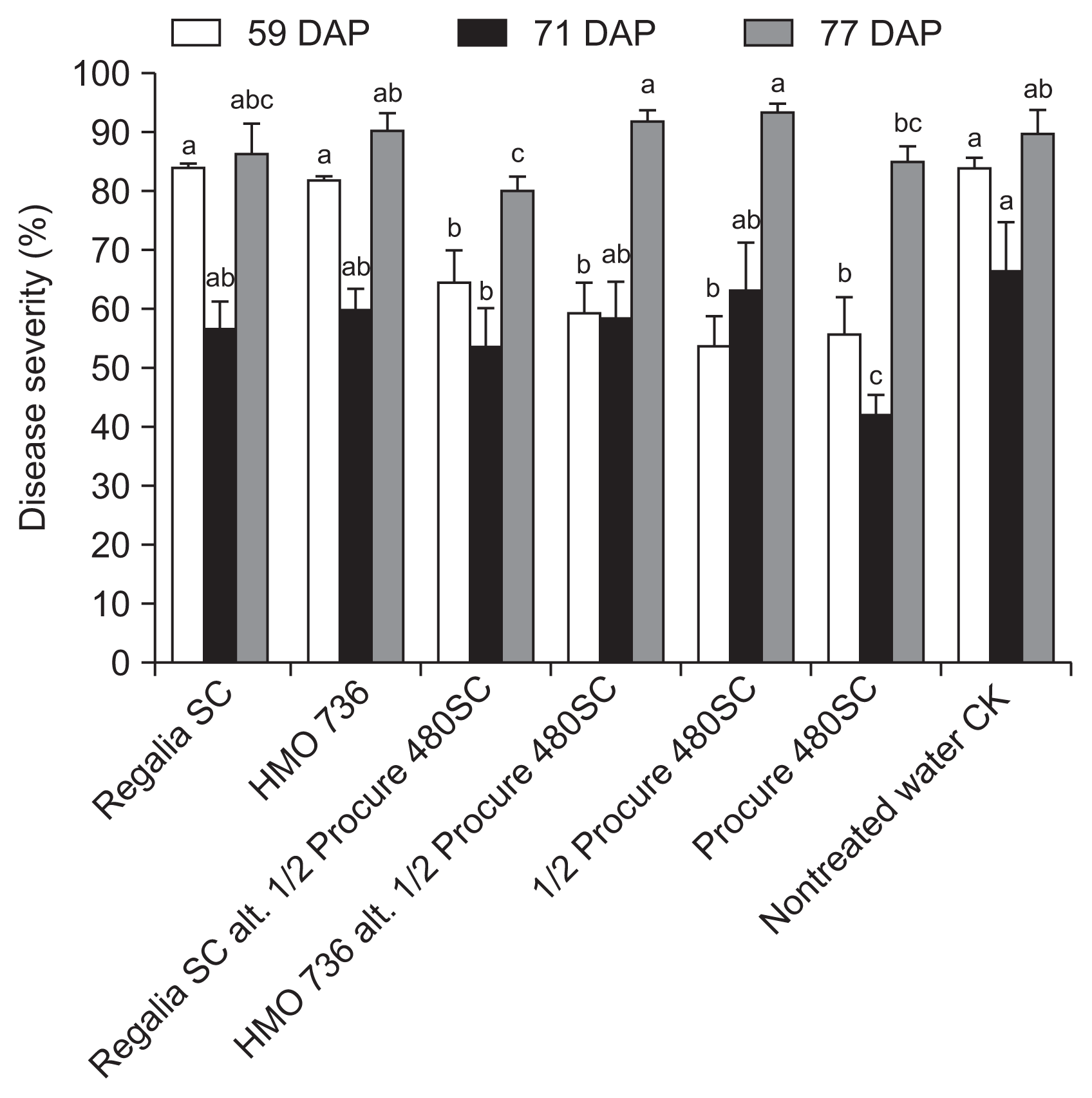
Efficacy of biopesticides Regalia SC and HMO 736 on powdery mildew of summer squash ‘Medallion’ (field trial 2). The application rate was 1% (v/v) for Regalia SC and 1.02 l/ha for HMO 736 which was equivalent to 2.74 ml/l for application in the greenhouse based on the application volume of 383 l/ha. Procure 480SC was applied at a half label rate (292 ml/ha). Treatments were applied once a week for the biopesticides alone, and once every 2 weeks for each of the biopesticides and Procure 480SC in alternating (alt.) treatments, and for Procure 480SC alone. Disease severity was assessed on five randomly selected plants per plot 59, 71, and 77 days after planting (DAP) as the percentage of the leaf surface covered with powdery mildew lesions on fully developed leaves. Means on each rating date followed by the same letter are not significantly different (P = 0.05) according to the least significant difference test. Bars represent the standard error of the mean.
Discussion
Management of powdery mildew is difficult because highly effective measures are limited and resistance to some fungicides has been documented. Results from this study on the biopesticides of Regalia SC and HMO 736 revealed promise for integrated management of this important disease of squash in south Florida. Regalia SC applied alone or in combination with the chemical standard Procure 480SC significantly (P < 0.05) reduced powdery mildew disease compared to the non-treated control in the greenhouse, and was as effective as Procure 480SC in 4 of 5 trials. HMO 736 alternated with Procure 480SC significantly improved powdery mildew control over Procure 480SC alone and the non-treated control. In the field trials, application of Regalia and HMO 736 each alone significantly reduced powdery mildew disease severity during the early stage of disease development. Both Regalia SC and HMO 736 each applied in alternation with Procure 480SC significantly improved the efficacy for control of powdery mildew compared to Procure 480SC alone. Results from this study demonstrated that the biopesticides Regalia SC and HMO 736 can be integrated in integrated management programs with labeled chemical fungicides for improved management of powdery mildew in squash in South Florida.
It is suggested that biopesticide applications be started prior to appearance of disease symptoms to effectively control downy mildew in cucurbits (McGrath and Shishkoff, 1999). In field trials of this study, levels of powdery mildew suppression achieved by applying the biopesticides Regalia SC and HMO 736 in alteration with a conventional fungicide Procure 480SC in field trial 1 were greater than in trial 2. This could be, at least in part, caused by discrepancies of application timing over powdery mildew appearance. In field trial 1, applications were started prior to the detection of powdery mildew symptoms, whereas the application was initiated after disease onset in field trial 2. This indicates that best efficacy of biopesticides against powdery mildew in squash can be achieved when they are applied before appearance of symptoms. Inappropriate timing of biopesticide applications could be an important reason for variations in efficacy for disease control. Careful monitoring of powdery mildew onset is critical to successful control of this important diseases in squash.
It is difficult to adequately control powdery mildew without including a systemic synthetic fungicide (McGrath and Shishkoff, 1999). Although biopesticides alone may be inadequate for effective disease control throughout an entire growing season, biopesticides can be applied when the disease pressure is low or incorporated into a management program particularly under high disease pressure (Zhang et al., 2011). In particular, combining or alternating application of microbial biopesticides with synthetic fungicides can significantly improve control levels of powdery mildew in cucurbits (McGrath and Shishkoff, 1999; Zhang et al., 2011). Results from this present study are in agreement with the findings from the above studies. In our field trial 1, treatments with biopesticides Regalia SC and HMO 736 applied in alternation with Procure 480SC significantly reduced powdery mildew on all rating dates and the overall AUDPC (Fig. 1). Alternating applications of these products with Procure 480SC significantly improved control levels at the late stage of disease development (based on the assessment at 88 DAP) relative to the biopesticides or Procure 480SC alone. Considering the benefit from an economic and environmentally safe standpoint, growers who do not want to rely on conventional fungicides could use biopesticides for control of powdery mildew exclusively when disease pressure is low, but will need to apply a biopesticide in rotation with a conventional systemic fungicide under high disease pressure. A possible theoretical approach is to apply biopesticides until the disease pressure reaches a threshold, then switch to the alternating use of a conventional fungicide when disease pressure increases or when climate conditions become more conducive to disease development. Further research is warranted to establish this theoretical threshold and document that this approach could be effective.
Acknowledgments
We thank Richard See and Troy Ledford for donating squash seed used in this study. We also thank Thomas White for his technical assistance and Waldemar Klassen for critically reviewing this manuscript. This study was supported in part by a grant from USDA IR-4.
Trade names in this publication are used solely for the purpose of providing specific information. Such use herein is not a guarantee or warranty of the products named and does not signify that they are approved to the exclusion of others. Mention of a proprietary product does not constitute an endorsement by the University of Florida nor does it imply lack of efficacy of similar products not mentioned.
Notes
Articles can be freely viewed online at www.ppjonline.org.
